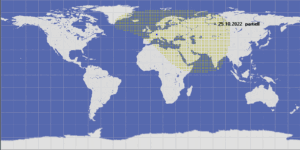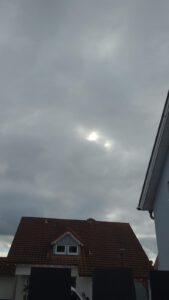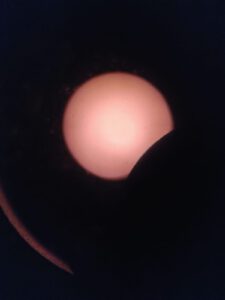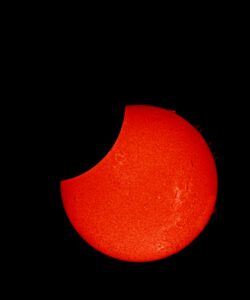Partial solar eclipse on October 25, 2022
The observatory was open to visitors on October 25 from 10:30 a.m. to 1:30 p.m. to observe the partial solar eclipse. Our member Otmar Becker observed the solar eclipse from home and is showing it as a live screen on his Facebook page:
Otmar Becker | Facebook
A solar eclipse can only occur at new moon. The moon is then between the sun and the earth. Another prerequisite is that the moon is on the ecliptic, the path of the sun, or at least very close to this path. Only then does its shadow have a chance of falling on the Earth. If the moon is above or below the ecliptic, its shadow falls past the earth.
 The dotted area on this world map is the area where the solar eclipse was visible. It is all of Europe except southern Spain and Portugal, then north-east Africa, the Middle East with the Arabian Peninsula, India, Sri Lanka, the western half of North Asia and China and the Himalayan states.
The dotted area on this world map is the area where the solar eclipse was visible. It is all of Europe except southern Spain and Portugal, then north-east Africa, the Middle East with the Arabian Peninsula, India, Sri Lanka, the western half of North Asia and China and the Himalayan states.
For Zweibrücken, the eclipse began at 11:12 am. The moon's disk then touched the sun's disk.
The eclipse reached its peak at 12:09. 20 percent of the sun's disk was covered by the moon. At 13:07, the moon released the sun again. The eclipse was over.
 This photo shows what the sky looked like for the most part. The sun could hardly be seen, at best it could be guessed. In places, the clouds were a little thinner and occasionally allowed the sun to shine through. After the beginning of the occultation, you could at least see through solar eclipse glasses that the sun already looked a little nibbled.
This photo shows what the sky looked like for the most part. The sun could hardly be seen, at best it could be guessed. In places, the clouds were a little thinner and occasionally allowed the sun to shine through. After the beginning of the occultation, you could at least see through solar eclipse glasses that the sun already looked a little nibbled.
During the first hour, many visitors left again, probably disappointed with the weather.
Shortly after twelve o'clock, at the height of the eclipse, the sky suddenly cleared in a wide area around the sun. The sun could no longer be overlooked.
The following photo was taken through the observatory's telescope.
 With the naked eye, you could clearly see the white sun, partially covered by the moon, through the eclipse glasses.
With the naked eye, you could clearly see the white sun, partially covered by the moon, through the eclipse glasses.
Those visitors who held out longer were rewarded with an excellent view of the sun, which was partially covered by the moon.
We will have to wait until March 29, 2025 for the next partial solar eclipse. A total solar eclipse is scheduled for 12 August 2026. The path of totality begins on Greenland, then runs through the Atlantic and ends in northern Spain in the Santiago de la Compostela area. In Zweibrücken, it will be visible as a partial eclipse, which will be much more impressive than what we have seen today.
The photo of the solar eclipse shown on the right was taken by our member Rolf-Dieter Schad with the Solarmax, the Solar telescope at the observatory. A number of prominences (gas eruptions from the sun) can be seen, particularly on the right-hand edge of the sun.
Solar telescope at the observatory. A number of prominences (gas eruptions from the sun) can be seen, particularly on the right-hand edge of the sun.
